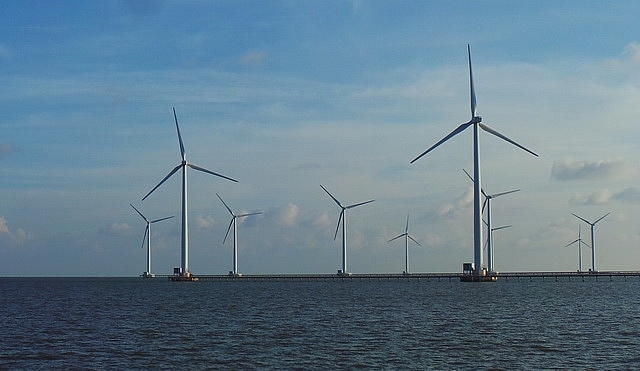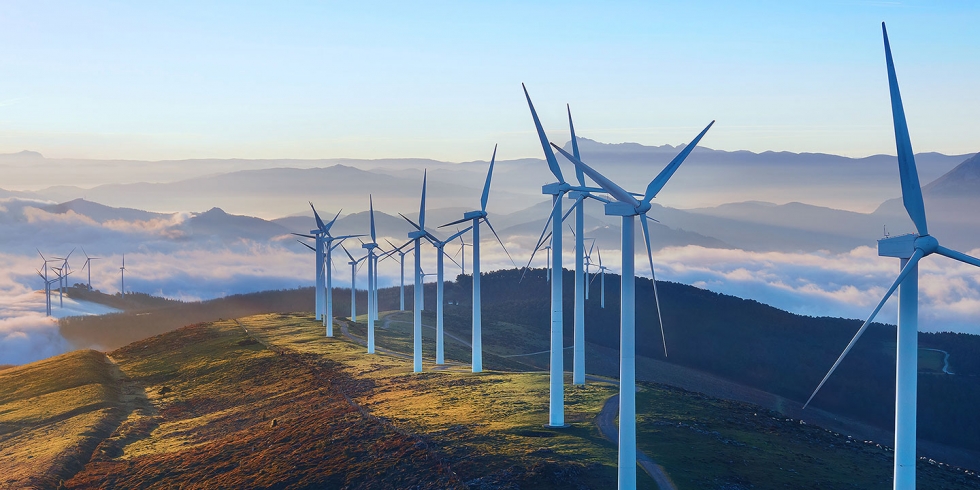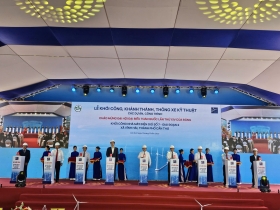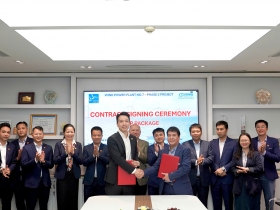Opportunities and challenges in developing wind power in Vietnam
04/01/2020
With a coastline of more than 3,000 km and a sea area of more than 1 million km2 and many islands and wind speeds onshore of more than 5 m/s, Vietnam is assessed to have great potential for wind power development. Offshore wind power development is also a major source of support for sea and island protection and a future strategy for the oil and gas industry to reuse the rigs. However, the current development of wind power in our country is still quite modest. This article will highlight the opportunities, challenges and solutions for developing wind power in Vietnam.
The exploitation, production and consumption of fossil-origin energy such as oil, gas and coal are the main causes of the increase in greenhouse gas (especially CO2), the main culprit for global warming since 1950. Energy, Industrial and transportation sectors generate 42, 20 and 17% of the global CO2 emissions, respectively. Although many energy-saving technologies and solutions have been implemented in many countries, the demand for energy is increasing due to the rapid increase in the world population, especially in developing countries. With the current trends, the total global energy demand has now doubled compared to 1980 and will increase by another 85% by 2050. This huge increase in energy demand has led to increased exploitation of traditional energy sources (mainly fossil origin) and development of alternative energy sources. However, the sources of fossil fuels are inadequate.
Meanwhile, other sources of energy such as hydraulic power are very sensitive to ecosystems and natural disasters such as floods, earthquakes ... Nuclear power is becoming increasingly costly, with risks of insecurity and lack of long-term measures for nuclear waste. Therefore, energy technologies in developed countries are now turning to clean and renewable energy sources such as the sun, wind, biogas, waves and tides. Exploiting wind energy is the fastest-growing due to many advantages such as: reasonable price, using land or sea surface for a unit of low power and least impact on the ecosystem. .. In many countries, large wind power plants have been built and connected to the national grid, small scale wind turbines have also been used to supply electricity to households. Wind power is also a major source of energy development strategies for many countries. By 2050, the US will have 35% of all federal electricity produced from the wind, China will build 1,000 GW of wind power and provide 17% of the electricity nationwide. India also targets 30-35% of wind power, Japan will build 75 GW of wind power and provide 20% of electricity. Especially in the Republic of Ireland, wind power after exceeding domestic demand will be exported from 2020.
Current status of wind power development in Vietnam
Wind power projects in Vietnam
The potential for developing wind power in Vietnam is enormous, estimated onshore about 27 GW, corresponding to an average wind speed of 5.5 to 7.3 m / s. According to calculations, this potential is 11 times the capacity of Son La Hydroelectric Plant (2.4 GW) and more than 14 times the capacity of Hoa Binh Hydroelectric Plant (1.9 GW). Besides, with more than 3,000 km of coastline and a total area of about 1 million km2 (3 times the land area) is also a great potential for offshore wind power. According to recent research by the Vietnam Sea and Islands Research Institute, the wind energy potential at an altitude of 80 m at sea with wind speed of 8 m / s is 1.3 thousand GW.
Although our country has abundant renewable energy sources as well as many mechanisms and policies to support the development of wind power, investors only consider Vietnam as a potential market but not exploit. The country currently has 48 registered wind power projects with a total capacity of nearly 500 MW, but only 7 wind power projects are operating with a total capacity of 190 MW.
Meanwhile, other sources of energy such as hydraulic power are very sensitive to ecosystems and natural disasters such as floods, earthquakes ... Nuclear power is becoming increasingly costly, with risks of insecurity and lack of long-term measures for nuclear waste. Therefore, energy technologies in developed countries are now turning to clean and renewable energy sources such as the sun, wind, biogas, waves and tides. Exploiting wind energy is the fastest-growing due to many advantages such as: reasonable price, using land or sea surface for a unit of low power and least impact on the ecosystem. .. In many countries, large wind power plants have been built and connected to the national grid, small scale wind turbines have also been used to supply electricity to households. Wind power is also a major source of energy development strategies for many countries. By 2050, the US will have 35% of all federal electricity produced from the wind, China will build 1,000 GW of wind power and provide 17% of the electricity nationwide. India also targets 30-35% of wind power, Japan will build 75 GW of wind power and provide 20% of electricity. Especially in the Republic of Ireland, wind power after exceeding domestic demand will be exported from 2020.
Current status of wind power development in Vietnam
Wind power projects in Vietnam
The potential for developing wind power in Vietnam is enormous, estimated onshore about 27 GW, corresponding to an average wind speed of 5.5 to 7.3 m / s. According to calculations, this potential is 11 times the capacity of Son La Hydroelectric Plant (2.4 GW) and more than 14 times the capacity of Hoa Binh Hydroelectric Plant (1.9 GW). Besides, with more than 3,000 km of coastline and a total area of about 1 million km2 (3 times the land area) is also a great potential for offshore wind power. According to recent research by the Vietnam Sea and Islands Research Institute, the wind energy potential at an altitude of 80 m at sea with wind speed of 8 m / s is 1.3 thousand GW.
Although our country has abundant renewable energy sources as well as many mechanisms and policies to support the development of wind power, investors only consider Vietnam as a potential market but not exploit. The country currently has 48 registered wind power projects with a total capacity of nearly 500 MW, but only 7 wind power projects are operating with a total capacity of 190 MW.

Offshore wind farm (For illustration purposes only)
The financial mechanism for wind power development
Aiming to develop wind power to reach 1 GW (4% of total national electricity output) in 2020 and 6.2 GW (6%) in 2030, the Government has several preferential policies for electricity development, such as: import tax exemption, tax reduction for locations where wind turbines are located, tax exemption for the first 4 years from the time of commercial operation, 50% tax reduction for the next 9 years ... However , the price to buy wind power is still different in the price calculation method of the State and investors. Enterprises want the Government to offer attractive prices for investment. Meanwhile, the Government requires investors to implement the project, then adjust the purchase price of electricity according to the actual situation. According to Decision No. 37 / QD-TTg in 2011 on the mechanism to support the development of wind power projects in Vietnam, the purchase price for grid-connected wind power projects is 7.8 US cent / kWh, in EVN paid 6.8 US cent / kWh, the State supported EVN 1 US cent / kWh taken from Vietnam Environment Protection Fund. Currently, 3 wind power plants in Binh Thuan still sell for 7.8 US cent / kWh. Bac Lieu wind power plant was originally built with the price of 7.8 US cent / 1kWh (2012). The Government then agreed to buy all electricity at a preferential price of 9.8 US cent / kWh (2014) because wind turbines were placed onshore, pushing prices higher than offshore. The German Development Cooperation Organization (GIZ) said that the attractive price must be 9.8 US cents / kWh (26% higher than the proposed price) for onshore wind power and 11.2 US cents / kWh (nearly 44% higher) for offshore wind power.

Onshore wind farm (For illustration purposes only)
Although there are still some problems in the mechanism of wind power price, recently many international financial institutions such as World Bank (WB), Asian Development Bank (ADB), Japan Bank for International Cooperation Ban (JBIC), the German Bank for Reconstruction (KfW), the Dragon Capital Fund and several other banks were interested in wind power in Vietnam. The World Bank has granted a credit to the Renewable Energy Development Project (REDP) between 2009-2014. KfW also has several financing programs, such as a $ 35 million loan support for the recently completed Phu Lac 1 wind power project. Dragon Capital Investment Fund also established the Mekong Bhahmaputra Clean Development Fund to invest in clean energy, energy saving and environmental treatment programs with an initial capital of 45 million USD (about 100 million USD in next step). Vietnam Development Bank (VDB) also has many financial programs for renewable energy projects, medium and long-term investment loans, or on-lent ODA loans from the Government and banks. international cooperation.
Opportunities for developing wind power in our country
The development of wind power and Vietnam's huge wind power potential are opening up many opportunities for Vietnam's electricity industry to develop sustainably, in parallel with efforts to reduce climate change in the world and improve the nation's energy security. On the other hand, it is also an opportunity for the labor market, manufacturers, consultants, investors and construction contractors in the country.
Investors can develop wind power projects in the form of BOT (Build-Operate-Transfer) or IPP (Independent Power Producer). In the form of BOT, investors build and operate wind power plants in a certain period, then hand over the plant to the State (investors can also combine with EVN or with other investors). In the form of IPP, investors build and operate wind power plants for an infinite period of time. Currently, the IPP mechanism is only applicable to small power projects in Vietnam. One characteristic of domestic investors in Vietnam is the lack of experience in developing wind power projects. On the other hand, with Vietnam's huge offshore wind power potential (1.3 thousand GW), offshore wind power development is also a great source of support for island protection and the future strategy for the oil and gas industry to reuse the rigs. Moreover, the installation of offshore wind turbines has less impact on visibility and noise, and has less turbulence in the wind source, thus, can increase the speed of rotation and the length of wind blades. The power generated by offshore wind turbines can be up to 50% higher than onshore turbines thanks to higher and more stable wind speeds.
Onshore wind power plants usually only have a total capacity of less than 50 MW but the total capacity of an offshore wind power plant may be more than 100 MW. Foundations, grid connection and maintenance during operation are current challenges for offshore wind power. The cost of offshore wind turbines with fixed brackets often increases with the depth of the water, so this type is often uneconomical in deeper waters. Therefore, for offshore and deep seas, the turbines with floating brackets are most economical and reasonable, can install large-capacity turbines (5-10 MW) to minimize prices of electricity production.
Development challenges and solutions
In some developed countries, harnessing electricity from onshore wind turbines is close to the density limit. Onshore wind turbines also have lower generation capacity due to wind turbulence and the height of the pylons. At the same time, onshore wind turbines have some negative environmental impacts such as obstructing visibility and low-frequency noise, making it increasingly difficult to find new construction sites. Therefore, developing offshore turbines with fixed base and progressing to floating base is the strategic orientation of wind power industry.
The assessment of wind potential in Vietnam is also incomplete and inaccurate due to the lack of data. The World Bank, EVN and several researchers and consultants made different calculations based on research methods and priorities. For example, in 2001, the World Bank announced the highest wind energy potential of 65 m (513.36 GW) of Vietnam compared to Cambodia, Laos and Thailand; In 2007, EVN considered that the national technical capacity was only 1,785 GW; In 2010, the Ministry of Industry and Trade and the World Bank stated that the wind energy potential at an altitude of 80 m above the ground is more than 2,400 GW … Because there is no standard figure, investors must conduct wind measurements before investing 1 -2 years. In fact, 4 wind power plants connected to the national grid all produce electricity below expectations. Bac Lieu wind power plant only reaches the capacity factor of 25% in phase 1, 33% lower than expected. By phase 2, despite overcoming the technical error in phase 1 when the low-power turbines were detected at the end of the wind direction due to the impact of the turbines above, but the capacity was still lower than expected.
Opportunities for developing wind power in our country
The development of wind power and Vietnam's huge wind power potential are opening up many opportunities for Vietnam's electricity industry to develop sustainably, in parallel with efforts to reduce climate change in the world and improve the nation's energy security. On the other hand, it is also an opportunity for the labor market, manufacturers, consultants, investors and construction contractors in the country.
Investors can develop wind power projects in the form of BOT (Build-Operate-Transfer) or IPP (Independent Power Producer). In the form of BOT, investors build and operate wind power plants in a certain period, then hand over the plant to the State (investors can also combine with EVN or with other investors). In the form of IPP, investors build and operate wind power plants for an infinite period of time. Currently, the IPP mechanism is only applicable to small power projects in Vietnam. One characteristic of domestic investors in Vietnam is the lack of experience in developing wind power projects. On the other hand, with Vietnam's huge offshore wind power potential (1.3 thousand GW), offshore wind power development is also a great source of support for island protection and the future strategy for the oil and gas industry to reuse the rigs. Moreover, the installation of offshore wind turbines has less impact on visibility and noise, and has less turbulence in the wind source, thus, can increase the speed of rotation and the length of wind blades. The power generated by offshore wind turbines can be up to 50% higher than onshore turbines thanks to higher and more stable wind speeds.
Onshore wind power plants usually only have a total capacity of less than 50 MW but the total capacity of an offshore wind power plant may be more than 100 MW. Foundations, grid connection and maintenance during operation are current challenges for offshore wind power. The cost of offshore wind turbines with fixed brackets often increases with the depth of the water, so this type is often uneconomical in deeper waters. Therefore, for offshore and deep seas, the turbines with floating brackets are most economical and reasonable, can install large-capacity turbines (5-10 MW) to minimize prices of electricity production.
Development challenges and solutions
In some developed countries, harnessing electricity from onshore wind turbines is close to the density limit. Onshore wind turbines also have lower generation capacity due to wind turbulence and the height of the pylons. At the same time, onshore wind turbines have some negative environmental impacts such as obstructing visibility and low-frequency noise, making it increasingly difficult to find new construction sites. Therefore, developing offshore turbines with fixed base and progressing to floating base is the strategic orientation of wind power industry.
The assessment of wind potential in Vietnam is also incomplete and inaccurate due to the lack of data. The World Bank, EVN and several researchers and consultants made different calculations based on research methods and priorities. For example, in 2001, the World Bank announced the highest wind energy potential of 65 m (513.36 GW) of Vietnam compared to Cambodia, Laos and Thailand; In 2007, EVN considered that the national technical capacity was only 1,785 GW; In 2010, the Ministry of Industry and Trade and the World Bank stated that the wind energy potential at an altitude of 80 m above the ground is more than 2,400 GW … Because there is no standard figure, investors must conduct wind measurements before investing 1 -2 years. In fact, 4 wind power plants connected to the national grid all produce electricity below expectations. Bac Lieu wind power plant only reaches the capacity factor of 25% in phase 1, 33% lower than expected. By phase 2, despite overcoming the technical error in phase 1 when the low-power turbines were detected at the end of the wind direction due to the impact of the turbines above, but the capacity was still lower than expected.

The biggest challenges currently are the price of wind power and policies to support the purchase and sale of wind power for producers and consumers. Wind power purchase price in Vietnam is currently low compared to many countries in the world (Table 1). The immediate solution is to issue a more appropriate price policy for wind power, including onshore or offshore turbines such as Decision No. 39/2018 / QD-TTg. The next solutions are the purchase price according to the size of the project, according to the type of technology and the level of technology application in storage and auxiliary to regulate the grid used by the project. More long-term and more sustainable solutions such as the Republic of Ireland and other countries have implemented the issuance of a reasonable floor price for power producers and conducting public bidding between power producers and distributors. The bidding can take place weekly, even daily based on advanced technology in forecasting electricity demand.
In addition, there are two immediate challenges in developing offshore wind power. The first is the development of marine spatial integrated planning (Marine Spatial Planning) including surveying, constructing and managing wind, oceanographic, topographic geology, seabed topography, marine ecosystems, protected areas survival, defense and navigational channels. The proposed solution is the participation of many related agencies and ministries and a new State agency coordinating. The second is to build the power transmission system and store energy from offshore to the shore. The solutions to these two challenges are interrelated.
Other long-term solutions to the purchase price of wind power are strategies to reduce electricity production costs by improving the localization capacity of wind turbines. On the other hand, attract investors, consume and distribute wind power by reducing subsidies, increasing environmental fees for fossil-based electricity (coal, oil, gas) and ordering more stringent conditions to limit investors to develop fossil electricity. The Government can issue and support programs to raise awareness and attract the use of wind power in particular and from clean and renewable energy in general. Technology exchange and human resource building activities in the country through scientific and technical workshops, short-term and long-term training programs for businesses, research institutes and training institutions should be encouraged.
In addition, there are two immediate challenges in developing offshore wind power. The first is the development of marine spatial integrated planning (Marine Spatial Planning) including surveying, constructing and managing wind, oceanographic, topographic geology, seabed topography, marine ecosystems, protected areas survival, defense and navigational channels. The proposed solution is the participation of many related agencies and ministries and a new State agency coordinating. The second is to build the power transmission system and store energy from offshore to the shore. The solutions to these two challenges are interrelated.
Other long-term solutions to the purchase price of wind power are strategies to reduce electricity production costs by improving the localization capacity of wind turbines. On the other hand, attract investors, consume and distribute wind power by reducing subsidies, increasing environmental fees for fossil-based electricity (coal, oil, gas) and ordering more stringent conditions to limit investors to develop fossil electricity. The Government can issue and support programs to raise awareness and attract the use of wind power in particular and from clean and renewable energy in general. Technology exchange and human resource building activities in the country through scientific and technical workshops, short-term and long-term training programs for businesses, research institutes and training institutions should be encouraged.
References:
Dr. Dinh Van Nguyen - University of Cork, ireland
MSc Nguyen Xuan Hoa - Vietnam Maritime University
MSc Nguyen Thi Thu Huong - Military Technical Academy
Dr. Dinh Van Nguyen - University of Cork, ireland
MSc Nguyen Xuan Hoa - Vietnam Maritime University
MSc Nguyen Thi Thu Huong - Military Technical Academy
Other articles
- Sigma Is Honored and Proud to Attend the Groundbreaking Ceremony of Phase 2 of the Soc Trang 7 Nearshore Wind Farm (19/12/2025)
- Sigma Spreads the Spirit of Compassion – Calling for Participation in the 5th “Red Sunday” Program 2026 (06/11/2025)
- Sigma Successfully Signs Contract for the Soc Trang 7 Nearshore Wind Farm Project (Phase II) (07/11/2025)
- Carbon Credits and the Carbon Market in Vietnam: Interesting facts that you may not know (28/05/2022)
- Sigma Engineering - Affirming capacity and experience in the field of wind power (30/12/2021)
- The picture of renewable energy sources and potential development in Vietnam (16/12/2019)
- Sigma signed the contract for Phase 1 of Ben Tre V1.3 Offshore Wind Farm (29/11/2019)
- Overview of renewable energy and the development of renewable energy sources in the world (23/11/2019)
- Vietnam: Government is aming for the renewable energy (15/11/2019)
Partners








































_thumbcr_130x97.png)























 Address :
Address :  Email :
Email :  Tel : (84-24) 3 9288683 | (84-24) 3 9289235
Tel : (84-24) 3 9288683 | (84-24) 3 9289235 Fax : (84-24) 3 9288667
Fax : (84-24) 3 9288667.png)
